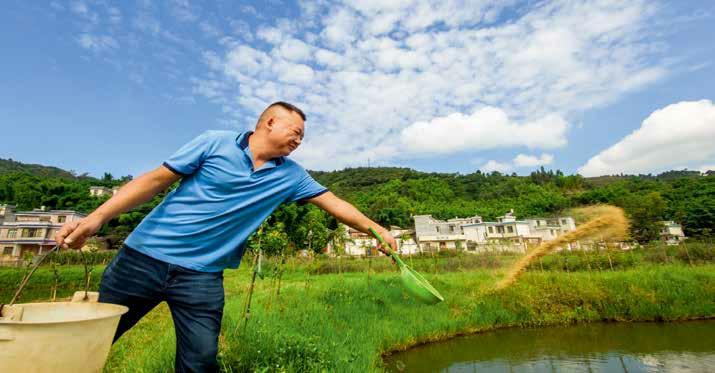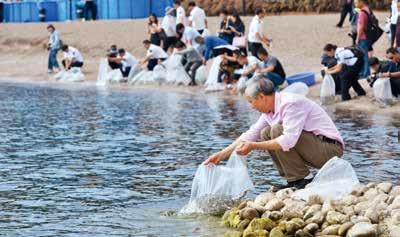The Story of a Fish Farmer
2021-12-09byZhangJingwen
by Zhang Jingwen


It takes a two-hour drive up twisty mountain roads from Kunming, capital of southwestern Chinas Yunnan Province, to reach Majiachong Village.
The village hosts an aquaculture farm with an area of 104 hectares operated by Yunnan Maowan Aquaculture Co., Ltd. When food is tossed into the tranquil water, hundreds of fish jump out to snatch it.
Yin Shumao, head of the company, said the fish were all rare Yunnan native species. Among them, the most important and abundant was the Kanglang white minnow, a fish species unique to Yunnan.
Half-way Fish Farmer
Southeastern Kunming is home to Fuxian Lake, a famous freshwater lake and the only habitat of the Kanglang white minnow.
To optimize the utilization of natural bait resources in the lake and improve the economic benefits of the aquaculture industry, in the 1950s and 60s, people introduced large fish including the Taihu lake icefish from the Yangtze River and other water systems. However, the newcomers soon developed into dominant populations in the lake.
Furthermore, the dense nets used to catch Taihu lake icefish caused serious damage to Kanglang white minnows. By the 1990s, the Kanglang white minnow had been removed from the list of the major edible fish in the lake area. The price of this fish soared to 3,000 yuan(US$469) per kilogram.
Yin Shumao smelled huge business opportunities in the staggering prices. Despite zero experience in aquaculture, he decided to give it a try. In 1995, no systematic research had been performed on the feasibility of artificially breeding Kanglang white minnows, but Yin boldly rented over a hectare of fish ponds to experiment with breeding the fish.
He has constantly improved the design of his fish ponds and adjusted the water pressure, quality, and temperature to provide an ideal aquaculture environment for the fish.
He also paid close attention to the fishs spawning habits as well as disease prevention and treatment. He cooperated with professional research institutions to develop special feeds and dramatically enhanced the reproduction and survival rates.
In 2012, Yin established a Kanglang white minnow breeding base and started to breed the fish in large scale with mature technology. Now, Maowan is recognized as a national-level demonstration aquaculture farm, and it has applied for 14 related patent rights.
So far, the bases annual incubation population of Kanglang white minnows has reached 120 million, with annual sales over 100 tons, creating more job opportunities for local people. A total of 400 villagers now work there.
Big Job for Small Fish
Yin Shumaos extensive work breeding and researching Kanglang white minnows not only boosted his career, but also helped him realize the importance of biodiversity to ecological conservation.
The Kanglang white minnow is an omnivorous animal, which not only eats phytoplankton, but also carcasses of Taihu lake icefish. After almost eliminating the competitor of the Kanglang white minnow, the Taihu lake icefish reproduced in large numbers in Fuxian Lake. However, it has only a one-year life cycle. Soon, carcasses of Taihu lake icefish dotting the surface were seriously polluting the lake. The local government hired people to remove the dead fish, but their efforts had little effect.
“The Kanglang white minnow is a lake savior,” said Yin. Taking weight into account, one unit of Kanglang white minnows can eat as many as 60 units of food, making the species an ideal“scavenger” for the lake. If the Kanglang white minnow returned to Fuxian Lake, it could play a big role in cleaning the water.
In 2007, the Fuxian Lake Administration of Yuxi City started to implement artificial culture of Kanglang white minnows. It now regularly releases fingerlings of a variety of endemic fish species including the Kanglang white minnow into Fuxian Lake. Yin actively participated in the activities and donated expensive Kanglang white minnow fingerlings many times. In the winter of 2018 and on Fuxian Lake Protection Day in 2019, he donated a total of 298,000 Kanglang white minnows to the Fuxian Lake Administration.
The long-term outcome from the donations did not disappoint Yin. Since 2018, the water quality of Fuxian Lake has remained at Grade I, the best quality. The small fish did a great job.
Greater Mission
After realizing the importance of coexistence of different species in the ecosystem, Yin started pondering the possibility of artificial breeding of indigenous fish.
Yunnan is home to six major river systems including the Yangtze River, Pearl River, and Lancang River as well as nine plateau lakes including Dianchi Lake, Erhai Lake, and Fuxian Lake. Yunnans well-developed water system, complex terrain, and wide-ranging climatic conditions have gifted it a diversified fish ecosystem.
By 2019, 629 species of freshwater fish had been discovered in Yunnan, accounting for 39.9 percent of the total in China, among which 594 are indigenous species and those unique to Yunnan took up as many as 255 categories. However, Yin sees plenty more work to do.
“Collecting fish germplasm resources is the most important work,” said Yin.“The process from collecting germplasm to successful breeding is long. After germplasm collection, the fish has a growth process from hatching to sexual maturity, during which the hybrid fingerlings must be sorted out and the pure and good ones kept.”
Over the years, Yin has continuously collected and cultivated indigenous fish species of Yunnan. Nowadays, his focus has expanded to many other rare Yunnan fish species such as the snow trout, bamboo carp, and golden-line barbel.
Meanwhile, support from the local government enabled Yin to begin building a “fish valley of Yunnan” as a germplasm bank of indigenous fish species. In the base, Maowan has preserved more than 140 indigenous fish species and started building a demonstration corridor of Yunnans indigenous fish to share the local fish with more people.